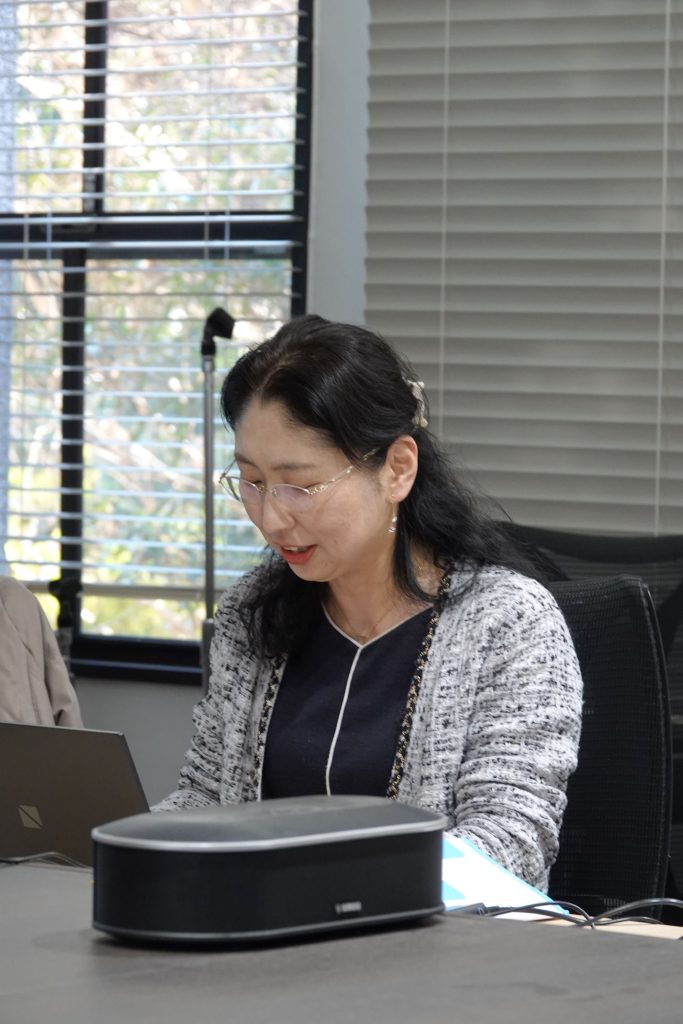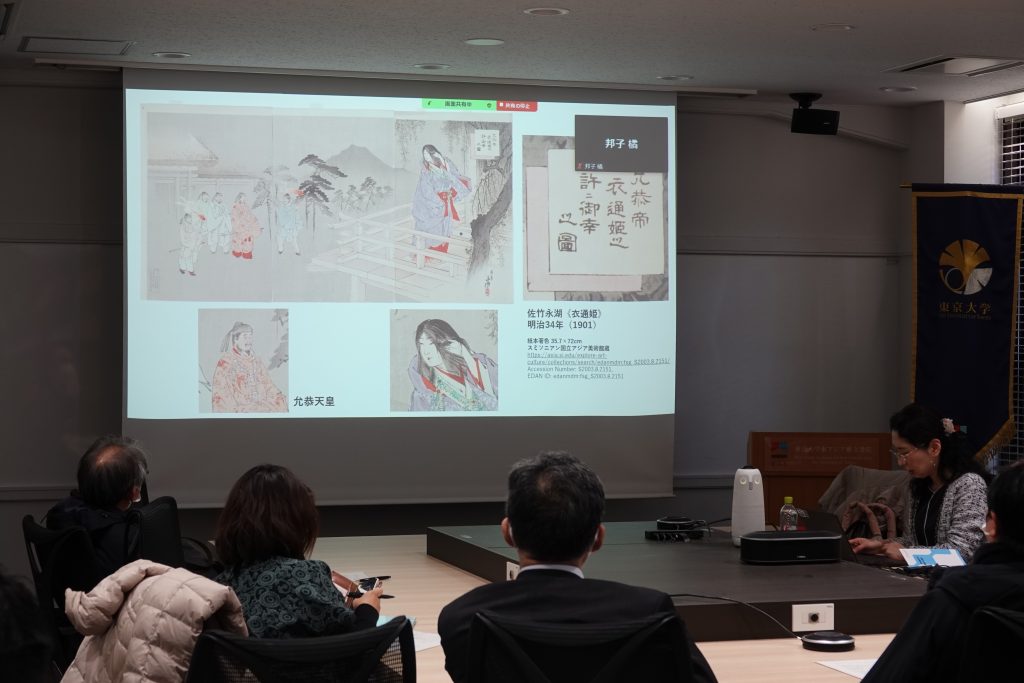On January 30, 2025, the 5th EALAI project seminar was held at Komaba. Professor Kumiko Nagai delivered a lecture titled “A Missing Connection Between ‘The Three Beauties in the World’ and ‘The Three Beauties in the Taisho Era’ : The Relevance of the Japanese Perspective on Beauties to Waka poetry.”

Who are “The Three Most Beautiful Women”? Many have been chosen because there has been a tendency in Japan to choose the top three in various categories, including beauties: “The Three Beauties in the Heian Era,” “The Three Beauties in the Genpei Period,” “The Three Beauties in the age of Civil Wars,” “The Three Beauties in the Kansei Era,” “The three beauties in the Taisho Era,” “The Three Beauties in the Showa Era,” “The Three Beauties in the World.” In this seminar, “The Three Beauties in the World” was studied, focusing on its connection with “The Three Beauties in the Taisho Era.”
Who comes to mind when you think of “The Three Beauties in the World” ? If Cleopatra, Yang Guifei, or Helen of Troy came up in your mind, you might already be familiar with the second version of it, which was revised “voluntarily” by the Japanese, influenced by a sense of inferiority and admiration toward the U.S. and, in particular, the impact of the movie Helen of Troy (Ref.1). Ono no Komachi, instead of Helen, was counted among “The Three Beauties in the World” in the Taisho Era, when this topic started to catch people’s ears. After the victories in the Sino-Japanese and the Russo-Japanese War, the revived national pride that Japan is comparable to the West and China was reflected in the selection of Komachi as Japan’s representative. Then, why were these three women chosen?
Cleopatra was widely known to the public in the Meiji era, influenced by the translation of many foreign books and articles. Then, she came to attract attention as the term “femme fatale” gained popularity in the end of the 19th century because she was exactly that one, who led the Ptolemaic dynasty to ruin. Similarly, Yang Guifei seemed to be highlighted again in modern times under the influence of the popularity of “femme fatale,” while she had been recognized since the Heian period through the famous poem The Song of Everlasting Regret as a woman whose beauty contributed to the decline of the Tang dynasty (Ref.2).
In contrast, Ono no Komachi is said to have caused the death of a man named Shosho of Fukakusa, however, she can hardly be described as “a devilish enchantress” as much as a “femme fatale.” Rather, she was often considered to be a “chaste woman” who steadfastly turned down his propositions a hundred times. It seems that she embodied an ideal of women for men of that era. Ono no Komachi therefore seems to have been selected based on a different axis of evaluation than that of “femme fatale.”
Professor Nagai sought to unravel the question of why Komachi was chosen over other Japanese women, by examining each figure in “The Three Beauties in the Taisho Era,” which drew much attention in Japan during the same period as the selection of “The Three Beauties in the World.”
Takeko Kujo, a daughter of the head of Nishi Hongwanji temple, married into a noble court family and was an accomplished waka poet. Byakuren Yanagihara, a poet, known for her turbulent love life, had married multiple times and eloped with a man seven years her junior while still married. Kinkin Egi, a geisha, committed suicide after the death of her husband. Kimuko Hayashi, a dancer, remarried shortly after her husband passed away and became the talk of the town. The fact that scandalous women attracted attention seems to have reflected the trend of preferring “femme fatale” in that era. On the other hand, the popularity of Takeko and Byakuren was attributed to the admiration for women from prestigious families. While Byakuren was a popular topic of conversation, Takeko was highly praised for her “chastity” during her husband’s long absence. She was especially popular during the period. It is probably because her reputation fitted the frame of the “ideal Japanese woman” of the time as a noble woman who was chaste and an accomplished poet. Waka poetry accordingly seems to have been exceptional among other arts.
The connection between waka poetry and “beauties” can be traced back to Sotoorihime, a princess of Emperor Ingyo in the 5th century, whose name was recorded in Kojiki and Nihon Shoki. She, who was said to have been radiantly beautiful, was worshipped as a goddess of waka poetry. There was even a movement to find a sacred nature in Ono no Komachi, which is illustrated in articles that said she was a descendent of Sotoorihime; in the Preface to the Kokin Wakashu, it is written, “Ono no Komachi follows the legacy and legend of ancient Princess, Sotoorihime.” Waka poetry seems to have had a special meaning as well beyond its position as “Japan’s unique traditional culture,” as it had the power to attract people.
Since then, beauties had been closely associated with excellence in poetry. In fact, the Kokin Wakashu states that “Ono no Komachi is a descendant of Sotoorihime.”
About 30 participants, including general attendees and experts, joined the seminar both onsite and online. We had lively discussions when the floor was opened for questions; ‘whether any women were chosen for reasons other than being a femme fatale or a poet,’ ‘whether the selection of beauties was made by men or women,’ ‘the significance of waka poetry for women of the era,’ and ‘the differences between waka poetry and other arts.’ ]
Professor Nagai further raised the issue of exploring the origin and history of the term “utahime” as an important topic for future research.
I was impressed by Professor Nagai’s attention to modern representations and media, TV advertisements, X, or ChatGPT, to investigate the sense of the people of today for “The Three Beauties in the World.” Additionally, her words and descriptions were impressive, being based on her exceptional insightsー”The Three Beauties in Kansei Era” as “idols whom people could go see” or Kujo Takeko as an “influencer.” They brightly made the women of those eras more relatable.
This seminar beautifully illustrated the mystery of why Komachi was selected as one of “The Three Beauties in the World” by referring to “The Three Beauties in the Taisho Era” and drawing an auxiliary line between poets and femme fatales.
I was particularly interested in the intention, or an ideology, behind the selection of these beauties: Nationalism in Japan. It was noted that mass opinion played a role in shaping “The Three Beauties in the Taisho Era.” According to E.H. Carr, “third-period nationalism,” which emerged in 1870 and developed further after 1914, is characterized by “the socialization of the state,” being based on popular support (Ref.3). This form of nationalism intended to integrate the new social classes into the nation. Then, in this context, the popularization of the top three beauties in the Taisho Era could be seen as an extension of the nationalism in Japan which had developed since the selection of Komachi.
Furthermore, as Isaiah Berlin indicated, nationalism is “an inflamed condition of national consciousness” and is often triggered by “wounds, some form of collective humiliation” (Ref.4). Then, the setback of nationalism during the Meiji era may have led to its resurgence following Japan’s victories in the First Sino-Japanese War and the Russo-Japanese War. I wonder if a certain form of nationalism, even today, has been fostered through the replacement of Komachi with Helen and the increasing adoption of Western beauty standards in Japan. If so, the “wounded nationalism” may be being seen in the form of supporting the popularity of cute singers, like Kyary Pamyu Pamyu or YOASOBI.

References
1) 永井久美子「「世界三大美女」言説と戦後日本の美人観——小町とヘレネの交代から考える」荒木浩ほか編『〈キャラクター〉の大衆文化 伝承・芸能・世界』, KADOKAWA, 2021
2) 永井久美子『「世界三大美人」言説の生成:オリエンタルな美女たちへの願望』,HMC, 2020
3) E.H.カー, 大窪愿二訳『ナショナリズムの発展』, みすず書房, 1952
4) I.バーリン, 福田歓一ら訳「曲げられた小枝」『バーリン選集4 理想の追求』岩波書店, 1992
Report by TAKAYAMA Shokei (Former EAA Youth)





